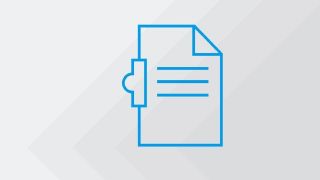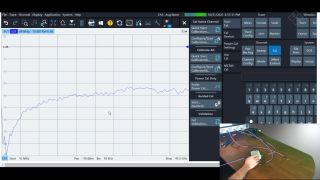Tests von PCIe (Peripheral Component Interconnect Express)
Praktisch alle Anforderungen an PCIe-Tests der Datenübertragung und Signaleigenschaften werden von Oszilloskopen erfüllt – sowohl während der Entwicklung als auch für PCIe-Konformitätsprüfungen. Auf der Bitübertragungsschicht bieten Netzwerkanalysatoren die größtmögliche Präzision für Signalintegritätstests. Mit einem automatisierten, Netzwerkanalysator-basierten Messaufbau, der nur von Rohde & Schwarz verfügbar ist, lässt sich der Zeitaufwand für Tests von Signalintegritätsparametern drastisch reduzieren. Außerdem profitiert die Zuverlässigkeit bei Tests von PCIe-Kabeln und -Steckverbindern mit vier oder mehr Lanes gemäß der Spezifikation 5.0 oder 6.0.
PCIe ist der De-facto-Standard für Verbindungen auf der Hauptplatine eines Servers oder PCs zwischen dem Hauptprozessor und den integrierten Peripheriekomponenten (oberflächenmontierten Chips) sowie einsteckbaren Peripheriekomponenten (Erweiterungskarten) wie Grafik- oder Speicherkarten und anderen Zusatzkarten. Für Hersteller von PCs, Chips und Steckkarten in der ganzen Branche stellt die Verifizierung von PCIe-Schnittstellen während der Entwicklung und später für die Funktionsverifizierung und Qualitätskontrolle in der Produktion eine kritische Aufgabe dar.
Die erste Version PCIe 1.0 datiert zurück auf das Jahr 2003. Sie bot eine Bandbreite von 8 GB/s bei einer Frequenz von 2,5 GHz und unterstützte 2,5 Gigatransfers pro Sekunde (GT/s). Seither wurde alle paar Jahre eine neue, leistungsfähigere Version von der PCI-SIG (Special Interest Group) veröffentlicht, die jeweils die doppelte Performance gegenüber dem Vorläufer bietet. Die neueste Version PCIe 6.0, die 2022 veröffentlicht wurde, sieht eine Bandbreite von 256 GB/s bei einer Frequenz von 32 GHz vor und unterstützt 64 GT/s. Die Datenraten werden in Transfers pro Sekunde angegeben und nicht als Bitrate wie sonst üblich. Dies geschieht deshalb, weil bei der Übertragung Datenbits in eine größere Anzahl von Übertragungszeichen konvertiert werden, um Übertragungsfehler zu reduzieren. Die größere Menge der zu übertragenden Informationen wird dafür in Kauf genommen. Bei PCI 1.0 und 2.0 kommt die Codierung 8b/10b zum Einsatz. Bei der Version 3.0 wurde der Overhead der Übertragung durch die Codierung 128b/130b erheblich verringert. Die Übertragungsfehler werden durch einen DC-Abgleich und begrenzte Diskrepanz (bounded disparity) erreicht – da auf lange Sicht zu 50 % eine „1“ und zu 50 % eine „0“ übertragen wird.
Die Codierung 128b/130b verringert aber nicht nur den Protokoll-Overhead von 25 % auf 1,5 %, sondern reduziert auch die protokollbasierte Übertragungsfehlerkorrektur. Seit PCIe 3.0 kommt Empfängerentzerrung zum Einsatz, um den kanalinternen Frequenzgang bei höheren Frequenzen zu kompensieren. Ausgefeilte Algorithmen zielen darauf ab, digitale Filter zu erstellen, die auf den Kanalverlust beim Empfänger abgestimmt sind.
PCIe baut Verbindungen über 1 oder mehrere Lanes eines Steckplatzes auf. Eine Lane enthält ein Sende- und ein Empfangspaar aus differenziellen Leitungen. Jede Lane nimmt somit einen Vollduplex-Stream auf, mit dem Datenpakete transportiert werden. Ein PCIe-Steckplatz kann zwischen einer und zweiunddreißig Lanes enthalten, wobei die Anzahl stets eine Zweierpotenz darstellt. Die Anzahl der Lanes wird mit dem Präfix „x“ angegeben – z. B. steht x16 für eine Karte oder einen Steckplatz mit sechzehn Lanes. Mehr als 16 Lanes kommen selten zum Einsatz. Ein x1-Steckplatz überträgt Daten mit 1 bit pro Zyklus, ein x16-Steckplatz entsprechend mit 16 bit pro Zyklus. Sowohl in Bezug auf Steckplätze als auch Versionen ist PCIe vollständig abwärtskompatibel, wobei sich die Datenrate immer nach der kleineren Steckplatzgröße und niedrigeren Version richtet.
Die kommerzielle Implementierung von PCIe hinkt dem neuesten Standard um mehrere Versionen hinterher. Noch immer sind mehr PC-Motherboards für PCIe 3.0 als für 4.0 auf dem Markt. Bauteile nach dem Standard 5.0 sind sogar noch seltener – denn es gibt nur wenige Anwendungen, die Datenraten von über 16 GT/s erfordern. Für die einfacheren Prozessoren, die in vielen Geräten für Industrie und Verbraucher arbeiten, bietet schon PCIe 1.0 mehr als genug Leistung.












